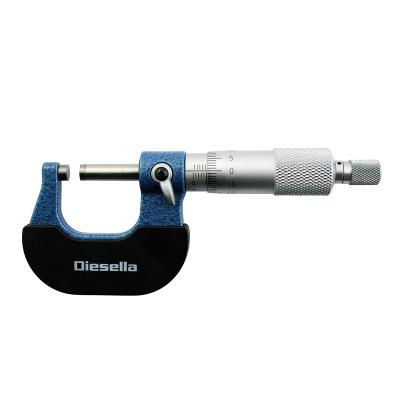An Outside Micrometer 0-25mm x 0.01mm (Manual) is a precision measuring instrument used to measure the external dimensions of objects with high accuracy. It is commonly used in mechanical engineering, metalworking, machining, and quality control applications. Here’s a detailed description of its features, construction, and typical uses:
Key Features:
1. Measurement Range:
- 0-25mm: The micrometer can measure objects ranging from 0 to 25 millimeters in external dimensions.
2. Resolution and Accuracy:
- Resolution: Typically provides a resolution of 0.01mm, allowing for very precise measurements.
- Accuracy: Generally accurate to within ±0.002mm or ±0.0001 inches, depending on the quality and calibration of the micrometer.
3. Construction:
- Frame: The frame is typically made of steel or cast iron for stability and minimal thermal expansion. It is designed to be rigid and durable.
- Anvil and Spindle: The measuring faces (anvil and spindle) are usually made of hardened steel or carbide-tipped for wear resistance and durability.
- Thimble and Sleeve: The thimble and sleeve are graduated, with the sleeve having a fixed scale and the thimble having a rotating scale to read measurements accurately.
4. Mechanical Components:
- Ratchet Stop or Friction Thimble: Ensures consistent pressure is applied during measurements, reducing user error and enhancing repeatability.
- Lock Nut: Allows the spindle to be locked in place, preserving the measurement reading.
5. Scale:
- Vernier Scale: The vernier scale on the thimble and sleeve allows for precise readings down to 0.01mm.
- Metric Units: The micrometer measures in metric units, typically in millimeters.
6. Ergonomics:
- Insulated Frame: Some models have insulated frames to minimize heat transfer from the user's hand, which can affect measurement accuracy.
- Smooth Operation: Designed for smooth and easy operation to enhance user comfort and reduce fatigue during repeated measurements.
Typical Uses:
1. Mechanical Engineering and Manufacturing:
- Component Inspection: Used to measure the dimensions of manufactured components to ensure they meet specified tolerances.
- Machining: Helps machinists measure parts during and after machining processes to ensure precision.
2. Metalworking:
- Fabrication: Used in metal fabrication shops to measure the thickness, diameter, and external dimensions of metal parts.
- Welding: Assists welders in measuring and checking the dimensions of welded components.
3. Quality Control:
- Inspection: Used in quality control departments to inspect incoming materials and finished products for adherence to specifications.
4. Automotive:
- Engine Work: Used by automotive technicians to measure engine components, such as piston diameters and valve stems.
5. Scientific Research:
- Precision Measurements: Used in laboratories and research settings for precise measurements of small components and materials.
Advantages:
- High Precision: Offers highly accurate measurements, essential for precision engineering and quality control.
- Durability: Made from robust materials, ensuring longevity and reliability.
- Consistency: Ratchet stop or friction thimble ensures consistent measurement pressure, reducing user error.
- No Battery Required: Unlike digital micrometers, manual micrometers do not require batteries, making them always ready for use.
Limitations:
- Reading Difficulty: Requires skill to read the vernier scale accurately, which might be challenging for beginners.
- Slower Operation: Can be slower to use compared to digital micrometers due to the manual reading process.
- Limited Range: Typically measures up to 25mm, so multiple micrometers might be needed for larger ranges.
Conclusion:
An Outside Micrometer 0-25mm x 0.01mm (Manual) is a highly precise and reliable tool widely used in various fields requiring accurate external measurements. Its robust construction, high accuracy, and consistency make it invaluable in mechanical engineering, manufacturing, metalworking, quality control, and scientific research. While it requires skill to read accurately and can be slower to operate compared to digital versions, its precision and durability make it an essential instrument for ensuring the accuracy and quality of small components and materials.
top of page
SKU: LI0068
No Reviews YetShare your thoughts.
Be the first to leave a review.
RELATED PRODUCTS
bottom of page

















